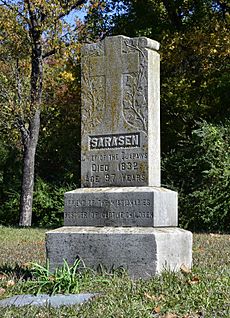Saracen (Quapaw chief) facts for kids
Quick facts for kids
Saracen
|
|
|---|---|
| Personal details | |
| Born | c. 1763 Arkansas Post, Arkansas, U.S. |
| Died | c. 1832 Jefferson County, Arkansas, U.S. |
| Resting place | St. Joseph Catholic Cemetery, Pine Bluff, Arkansas, U.S. |
Saracen, also known as Sarazin, Sarasen, and Sarasin, was a French-Quapaw man. In the 1800s, some European Americans called him an honorary "chief." Saracen witnessed his people, the Quapaw, being forced to move from their traditional lands in Arkansas. They were moved to a new area called Indian Territory.
Because Saracen had mixed-blood (meaning he had both French and Quapaw parents), he did not have the right to be a chief by birth. However, Anglo-Americans (white settlers) saw him as a chief because of his brave actions. A historian named Morris S. Arnold noted that while white neighbors thought Saracen was a hero, some Quapaw people did not agree. Saracen might have felt like he was "in between" two different cultures.
Biography
Saracen was born around 1763 at Arkansas Post, Arkansas. This area was once part of a French territory called La Louisiane. His father, François Sazarin, was an interpreter at Arkansas Post. François's parents were French settlers.
Saracen's father had a relationship with a Quapaw woman, who was Saracen's mother. Saracen was raised as a Quapaw. The Quapaw Nation confirms that Saracen had a Quapaw mother.
Local European-American settlers saw Saracen as a hero. He saved two white children who had been taken by Chickasaw people. The children were from a family of trappers near Pine Bluff. Saracen rowed down the Arkansas River at night. He found a Chickasaw camp near Arkansas Post. There, Saracen "lifted up his tomahawk and gave the Quapaw war cry." The Chickasaw people ran away, leaving the children behind.
For his brave action, Saracen received the Presidential Medal. This medal was given to him by James Miller, who was the Governor of the Arkansas Territory. In the 1820s, Governor Miller also named Saracen a chief of the Quapaw. This was an honorary title, as Saracen did not inherit the position.
Saracen was one of two leaders who signed a treaty in 1824. In this treaty, the Quapaw were pressured to give up their land in Arkansas to the United States government. In return, they were given land with the Caddo people on the Red River in northeastern Louisiana.
The Quapaw moved to this new land in early 1826. Sadly, floods destroyed their crops. About 60 people died from starvation, including Saracen's wife. Saracen then led about one-fourth of the Quapaw people back to land reserved for them on the Arkansas River. They reached this land in 1827.
In a letter from January 10, 1827, Governor George Izard described Saracen. Izard said Saracen was a "half-breed" and a very important warrior. He mentioned that Saracen was a hero, poet, and musician. Saracen was considered a chief in some ways. He was allowed to wear medals and attend tribal meetings. However, his honors were personal and would not pass to his son, unlike other chiefs who were full-blooded Indian.
During this time, the American government treated the Quapaw harshly. The Quapaw people split into two groups. One group was led by Chief Heckaton, who was the traditional leader. The other group was associated with Saracen by Governor James Miller. Miller appointed Saracen as the chief of this second group.
In 1833, Saracen signed another treaty with the U.S. government. In this treaty, the Quapaw agreed to give up their land in Arkansas. They also agreed to move to the northeastern part of the Indian Territory. Saracen did not go to the new reservation. Instead, he led 300 Quapaw people back to the Red River in Louisiana. Saracen later returned to Arkansas. He lived in Jefferson County until he passed away.
Saracen's gravestone at St. Joseph Catholic Cemetery in Pine Bluff says, "Friend of the Missionaries. Rescuer of captive children." The stone incorrectly states he died in 1832, as records show he lived longer than that year.
Legacy
- Lake Pine Bluff, a 500-acre lake in downtown Pine Bluff, was renamed Lake Saracen in his honor in 2007.
- A public art display in Pine Bluff includes a mural by Robert Dafford. This mural is dedicated to "Quapaw Chief Saracen, rescuer of the stolen children and legendary hero of Jefferson County."
- Saracen Casino Resort in Pine Bluff, opened by the Quapaw Nation in 2019, is named in Saracen's honor.


